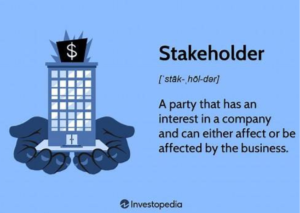Conflict between stakeholders:
Stakeholders are people, organizations, or groups that care about the company’s activities, outcomes, or performance. Stakeholders can be internal (inside the company) or external (outside the company).
Conflict could arise because stakeholders want different things from a business. Negotiation and a willingness to make concessions are often necessary to resolve a dispute.
An example of conflict is when the retail owners allow the business to open later on weekdays. The company will serve the public from 7 a.m. to 10 p.m. rather than 8 a.m. to 8 p.m. The owners hope this will boost profits but will likely cause conflict with other stakeholders.
The owners will need to keep an eye on potential conflicts:
It may be necessary for managers to work longer hours.
Employees may be required to work various shifts, including late shifts.
Some customers want the business to be open all day, every day.
Altering delivery times and routes could affect suppliers’ customers.
Increased noise and traffic could be disruptive to the neighborhood’s residents.
If pressure groups like those that advocate for families spending more time together or for better work-life balance have longer hours, they may be happier.
The government might need more resources, like police officers, to combat shoplifting at night and monitor its impact on the neighborhood.
4 Methods for Resolving Disputes and Cases Involving Stakeholders
Public and Open Communication: Effective communication is fundamental to conflict resolution. When administrators make conversations open and visible, stakeholders should be able to express their concerns and points of view. Sensitivity can forestall false impressions and build trust.
Example: A project manager successfully resolved a conflict by organizing a stakeholder meeting to address concerns about project timelines. By openly discussing problems and suggesting solutions, the manager secured the commitment and support of stakeholders.
Problem-Solving in a Team Setting: Stakeholders should be encouraged to actively participate in solving problems. Collaborative problem-solving cultivates stakeholder ownership and commitment and resolves immediate conflicts.
Example: During an organizational restructuring, a collaborative workshop was used to settle disagreements among department heads. The managers collectively created a restructuring strategy considering each department’s requirements, facilitating a more straightforward implementation.
 Facilitation and mediation of conflict: When tensions rise, managers may be called upon to play a mediator or facilitator role. This entails guiding stakeholders through structured discussions and negotiations to reach a beneficial solution for both parties.
Facilitation and mediation of conflict: When tensions rise, managers may be called upon to play a mediator or facilitator role. This entails guiding stakeholders through structured discussions and negotiations to reach a beneficial solution for both parties.
Example: A UK team leader facilitated a structured conversation to mediate a disagreement between two team members. The team members improved their working relationship by addressing the underlying issues and encouraging compromise.
Putting Win-Win Solutions into Action: Find solutions that benefit everyone. A win-win strategy considers stakeholders’ interests, resulting in long-term positive relationships and sustainable solutions.
Example: A UK product manager resolved a disagreement between the marketing and sales teams by reorganizing the product launch strategy. The revised plan addressed the concerns of both teams, leading to improved collaboration and successful product promotion.
Conclusion For professionals in the UK, resolving conflicts among stakeholders is an essential component of efficient management. Managers can successfully resolve conflicts by employing open communication, collaborative problem-solving, mediation, and win-win solutions.
In the ever-evolving business environment in the UK, skilled conflict resolution among stakeholders helps alleviate immediate issues and fosters trust and cooperation.
Managers facilitate smoother project implementations, improved team dynamics, and overall organizational success as they improve their conflict-resolution skills.

